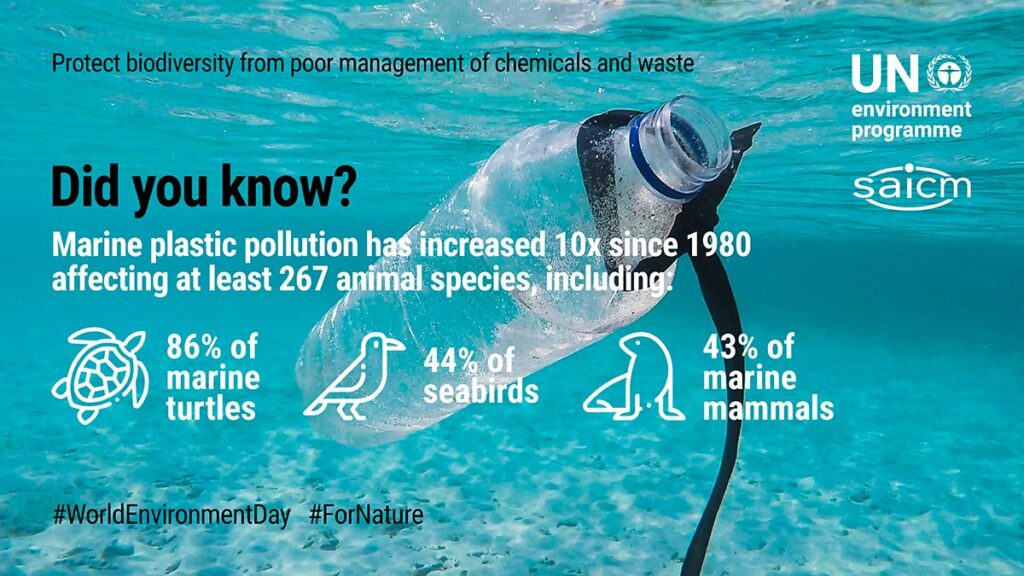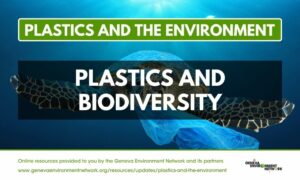Nouvelle
Plastics and Biodiversity | Plastics and the Environment Series
Plastic pollution is ubiquitous in the natural environment, with significant negative consequences on ecosystems and biodiversity. This page is part of our Plastics and the Environment series, a set of online resources on the plastics crisis, its impact on people and the environment, and international cooperation to address this global problem. They include resources and news from organizations in Geneva and beyond, including UN-system organizations and other IOs, governmental authorities, civil society organizations, academic institutions and journals, and renowned newspapers.
The world is facing a plastics crisis. Plastic pollution is found all around the globe. Plastics are negatively affecting people and the environment at each stage of their lifecycle – extraction of fossil fuel, production, manufacturing, use, recycling, and disposal. The impacts are felt in a wide range of areas, including on biodiversity, climate change, human health and human rights. This page focuses on the impacts of plastics on ecosystems and wildlife.
Plastics and Biodiversity at a Glance
Given the persistent nature of plastic and its toxicity, plastic pollution is a significant threat to biodiversity. It threatens ecosystems, animal and plant species, impeding their ability to deliver essential services to humanity. While the leakage of plastics into the ocean and the subsequent impacts of marine life has been most studied, plastic pollution also affect freshwater and terrestrial ecosystems.Indeed, plastic and chemical leakage into the environment may arise at various stage of the plastics life cycle, and the resulting pollutants are transported around the globe through air and oceans streams.
Environmental degradation occurs in the upstream, as extraction, fracking, production of plastics and chemical additives release substantial amounts of toxic substances into the air and contaminate the local environment. Disposal is also problematic: incineration of plastic waste releases toxic chemicals and micro- and nano-plastics into the air, while landfills contaminate soil and water. All these elements then impact biodiversity both locally and globally.

Impacts on Marine Ecosystems
Plastics are everywhere now even in the deepest part of the oceans. Global plastics production was estimated at 390.7 million metric tons in 2021, an annual increase of four percent. At least 14 million tons of plastic end up in the ocean every year, and plastic makes up 80% of all marine debris found from surface waters to deep-sea sediments (IUCN, 2021). Recent studies found an over 170 trillion plastic particles afloat in the world’s oceans. The result is an estimated $13 billion in annual environmental damage to marine ecosystems. Plastic pollution affects marine life through various pathways, including ingestion, entanglement, toxic impacts, and more. In a 2016 report, the Secretariat of the Convention on Biological Diversity (CBD) recognized that marine debris is a globally significant stressor on the marine and coastal environment, as studies show that almost 800 marine species are affected by plastic pollution.

Impacts of plastic waste on the marine environment. Source: GRID-Arendal, 2021.
Further resources on the impacts of plastic pollution on marine ecosystems:
- Tackling Sea-based sources of plastic pollution at the International Maritime Organization| Environmental Investigation Agency | 21 February 2024
- The plastic homes of hermit crabs in the Anthropocene | Zuzanna Jagiello, Łukasz Dylewski, Marta Szulkin | Science of the Total Environment | February 2024
- Microplastics found in Nile River’s tilapia fish: new study | The Conversation | 6 February 2024
- Global marine litter research 2015-2020: Geographical and methodological trends | 19 January 2024
- Plastic Has Changed Sea Turtles Forever | The Atlantic | 15 November 2023
- Clean-Ups or Clean-Washing? How plastic pollution cleanup technology can actually harm the environment and obstruct policy progress | EIA and OceanCare | 6 November 2023
- Microplastics found embedded in tissues of whales and dolphins | Duke University | 10 August 2023
- Plastic pollution on the world’s coral reefs | Pinheiro, MacDonald, Santos et al. | Nature | 12 July 2023
- Arctic Ocean sediments as important current and future sinks for marine microplastics missing in the global microplastic budget | Science Advances | 5 July 2023
- Where do Plastics in the Ocean Go? | Oceana and Newcastle University (UK) | 25 May 2023
- Halting Marine Biodiversity Loss by Closing The Plastic Tap | IUCN
- Single-use take-away cups of paper are as toxic to aquatic midge larvae as plastic cups | Bethanie Carney Almroth, Alice Carle et al. | May 2023
- The Great Pacific Garbage Patch is now so huge and permanent that a coastal ecosystem is thriving on it, scientists say | CNN | 18 April 2023
- Understanding the interactions between plastic particles and (trace) elements in water | Gilberto Binda et al. | 13 April 2023
- Combined toxic effects of nanoplastics and norfloxacin on mussel: Leveraging biochemical parameters and gut microbiota | Ran Xu, Li’ang Li et al. | 2023
- ‘Plasticosis’: the new disease killing seabirds and likely many other species | Elizabeth Claire Alberts | Mongabay | 9 March 2023
- A growing plastic smog, now estimated to be over 170 trillion plastic particles afloat in the world’s oceans – Urgent solutions requires | 5 Gyres Institute | 8 March 2023
- ‘Plasticosis’: Characterising Macro and Microplastic-associated fibrosis in seabird tissue | Journal of Hazardous Materials | 3 March 2023
- The African Marine Litter Outlook | Thomas Maes, Fiona Preston-Whyte, eds. | 2023
- Four IUCN economic case studies show the impacts of plastic pollution in the marine environment on biodiversity, livelihoods, and more in Africa and Asia | IUCN | 5 April 2022
- The Detrimental Impacts of Plastic Pollution on Animals | Earth.org | 4 May 2022
- Regulators missing pollution’s effect on marine life, study finds | The Guardian | 27 April 2022
- Impacts of Plastic Pollution in the Oceans on Marine Species, Biodiversity and Ecosystems | WWF | January 2022
- The Invisible Wave: Getting to Zero Chemical Pollution in the Ocean | Back to Blue (Economist Impact and The Nippon Foundation) | 2022
- Marine plastic pollution | IUCN | November 2021
- Baby marine turtles’ stomachs are full of harmful plastic debris, suggests new study | Suzanna Burgelman | Frontiers | 2 August 2021
- Aquatic Pollutants in Oceans and Fisheries | IPEN | April 2021
- Plastic pollution threatens the Mekong, a wildlife wonderland | UNEP | 25 March 2021
- Stanford analysis shows plastic ingestion by marine fish is a widespread and growing problem | Stanford News | 9 February 2021
- First-time study reveals high percentage of albatross deaths linked to single-use plastics | Massey University |9 February 2021
- Deadliest plastics: bags and packaging biggest marine life killers, study finds | The Guardian | 13 December 2020
- Plastic Pollution and Ocean Acidification Together Threaten Marine Life | AZoCleantech | 9 November 2020
- The hidden threat of plastic leachates: A critical review on their impacts on aquatic organisms | Kuddithamby Gunaalan et al. | Water Research | 1 October 2020
- Plastic pollution threatens marine biodiversity in South-East Asia | SEA Circular | 4 June 2020
- Research highlights impact of plastic pollution on marine life | Queen’s University Belfast | 29 April 2020
- A Plague of Plastics | American National Wildlife Federation | 1 June 2019
- Research highlights true impacts of plastics on our planet, ecosystems, people | UNEP News | 12 March 2019
- The Effects of Plastic on Biodiversity | ESRI | 2018
- Plastic, plastic everywhere | Ocean Care | 2017
- Marine Debris: Understanding, Preventing and Mitigating the Significant Adverse Impacts on Marine and Coastal Biodiversity | Secretariat of the Convention on Biological Diversity | 2016
- Sources, fate and effects of microplastics in the marine environment | GESAMP – IMO, FAO, UNESCO-IOC, UNIDO, WMO, IAEA, UN, UNEP, UNDP | 2015
Impacts on Terrestrial Ecosystems
While ocean plastic pollution has for long been the center of media and public attention, scientific assessments are confirmed the detrimental impacts on plastic pollution on freshwater and soil, thus affecting ecosystems all over the globe.
- Plastics treaty text must center ecosystems | Ina Tessnow-Von Wysocki, Mengjiao Wang, Carmen Caselles et al. | Science | 2 November 2023
- Plastic waste found chemically bonded to rocks in China | Katherine Bourzac | Nature | 12 April 2023
- Microplastics pollution found in fresh-fallen Sierra snow and Lake Tahoe | CBS News Bay Area | 19 March 2023
- Brazilian researchers find ‘terrifying’ plastic rocks on remote island | Sergio Queiroz | Reuters | 16 March 2023
- Greenpeace Study: Deep in Taiwan’s Forests, Microplastics Are Found in Bear Feces | Bloomberg | 23 August 2022
- Pandemic face masks could harm wildlife for years to come| James Ashworth | Natural History Museum | 4 August 2022
- Plastic pollution: Birds all over the world are living in our rubbish | BBC | 4 August 2022
- The Detrimental Impacts of Plastic Pollution on Animals | Earth.org | 4 May 2022
- Ocean Plastic Is Bad, but Soil Plastic Pollution May Be Worse | Civil Eats | 23 February 2022
- Assessment of agricultural plastics and their sustainability: A call for action | FAO | 2021
- Plastic planet: How tiny plastic particles are polluting our soil | UNEP | 22 December 2021
- World Migratory Bird Day: birds globally threatened by plastic waste | UNEP News | 9 May 2019
- What is the Effect of Plastic in Forests and Wildlife? | RePurpose | 1 May 2019
- An underestimated threat: Land-based pollution with microplastics | Leibniz-Institute of Freshwater Ecology and Inland Fisheries | 5 February 2018
Addressing Biodiversity in the Global Plastics Treaty
UNEA made history in March 2022, by adopting a resolution setting up the path to a global treaty to end plastic pollution. The resolution requests the convening of an intergovernmental negotiating committee (INC) to develop an international legally binding instrument on plastic pollution, including in the marine environment, during the second half of 2022, with the ambition of completing its work by the end of 2024.
At the 3rd session (INC-3) of the INC, held in Nairobi in November 2023, delegates mandated the Secretariat to compile a “revised zero-draft text (UNEP/PP/INC.4/3). While no intersessional work was agreed upon before INC-4, negotiators and experts involved in the process have continued to build and share knowledge to inform negotiations. IUCN and its World Commission on Environmental Law released in the context of a Geneva Beat Plastic Pollution Dialogue a brief discussing the importance of including a specific article on the connections between plastic pollution, circular economy solutions, and biodiversity and ecosystems protections. Protecting and restoring biodiversity, and nature per se must be incorporated in the legally binding control measures and enforcement terms of the ILBI.
More on the Plastics Crisis
Our special series « Plastics and the Environment » provides resources on the status of the global plastic pollution, its impact on people and the environment, and international cooperation to address the plastics crisis.

